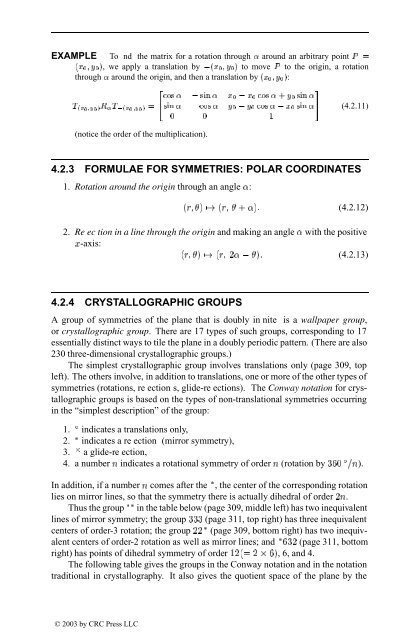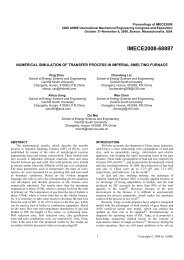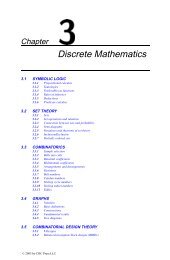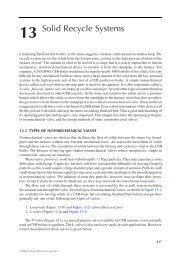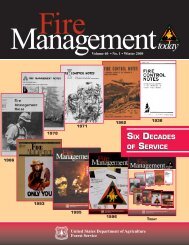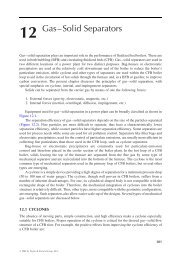Chapter 4: Geometry
Chapter 4: Geometry
Chapter 4: Geometry
Create successful ePaper yourself
Turn your PDF publications into a flip-book with our unique Google optimized e-Paper software.
EXAMPLE To nd the matrix for a rotation through « around an arbitrary point È <br />
´Ü ¼Ý ¼µ, we apply a translation by ´Ü ¼Ý ¼µ to move È to the origin, a rotation<br />
through « around the origin, and then a translation by ´Ü ¼Ý ¼µ:<br />
̴ܼ ݼµÊ «Ì ´Ü¼Ý¼µ <br />
(notice the order of the multiplication).<br />
¾<br />
<br />
Ó× « ×Ò « Ü ¼ Ü ¼ Ó× « · Ý ¼ ×Ò «<br />
×Ò « Ó× « Ý ¼ Ý ¼ Ó× « Ü ¼ ×Ò « (4.2.11)<br />
¼ ¼ ½<br />
¿<br />
4.2.3 FORMULAE FOR SYMMETRIES: POLAR COORDINATES<br />
1. Rotation around the origin through an angle «:<br />
´Öµ ´Ö · «µ (4.2.12)<br />
2. Re ec tion in a line through the origin and making an angle « with the positive<br />
Ü-axis:<br />
´Öµ ´Ö ¾« µ (4.2.13)<br />
4.2.4 CRYSTALLOGRAPHIC GROUPS<br />
A group of symmetries of the plane that is doubly in nite is a wallpaper group,<br />
or crystallographic group. There are 17 types of such groups, corresponding to 17<br />
essentially distinct ways to tile the plane in a doubly periodic pattern. (There are also<br />
230 three-dimensional crystallographic groups.)<br />
The simplest crystallographic group involves translations only (page 309, top<br />
left). The others involve, in addition to translations, one or more of the other types of<br />
symmetries (rotations, re ection s, glide-re ections). The Conway notation for crystallographic<br />
groups is based on the types of non-translational symmetries occurring<br />
in the “simplest description” of the group:<br />
1. Æ indicates a translations only,<br />
2. £ indicates a re ection (mirror symmetry),<br />
3. ¢ a glide-re ection,<br />
4. a number Ò indicates a rotational symmetry of order Ò (rotation by ¿¼ Æ Ò).<br />
In addition, if a number Ò comes after the £ , the center of the corresponding rotation<br />
lies on mirror lines, so that the symmetry there is actually dihedral of order ¾Ò.<br />
Thus the group ££ in the table below (page 309, middle left) has two inequivalent<br />
lines of mirror symmetry; the group ¿¿¿ (page 311, top right) has three inequivalent<br />
centers of order-3 rotation; the group ¾¾ £ (page 309, bottom right) has two inequivalent<br />
centers of order-2 rotation as well as mirror lines; and £ ¿¾ (page 311, bottom<br />
right) has points of dihedral symmetry of order ½¾´ ¾ ¢ µ, 6, and 4.<br />
The following table gives the groups in the Conway notation and in the notation<br />
traditional in crystallography. It also gives the quotient space of the plane by the<br />
© 2003 by CRC Press LLC


